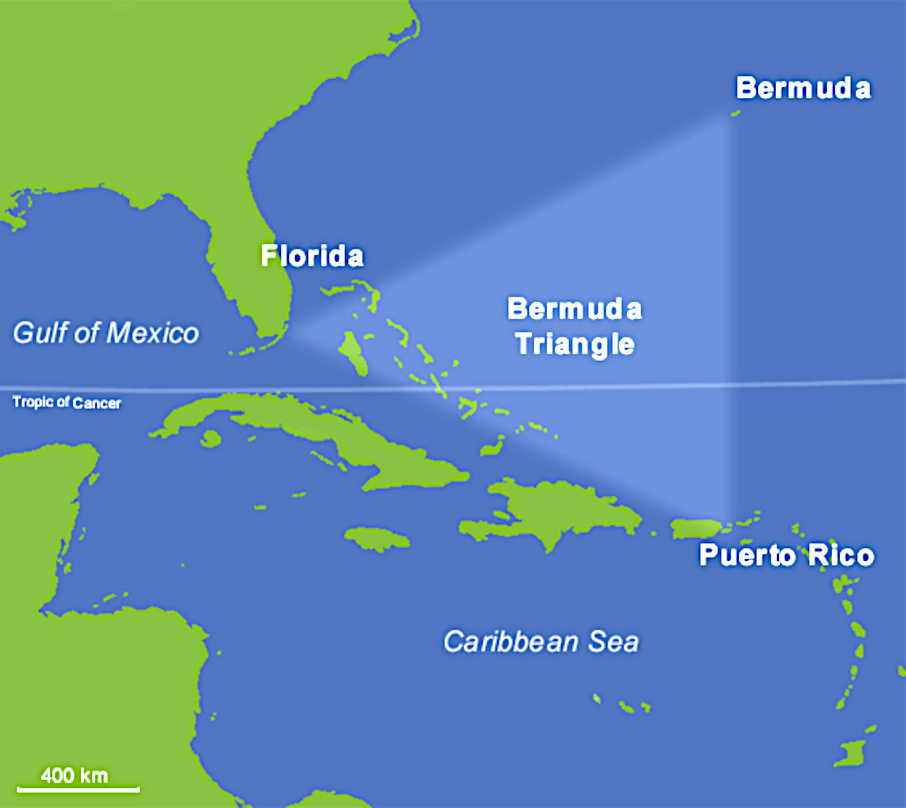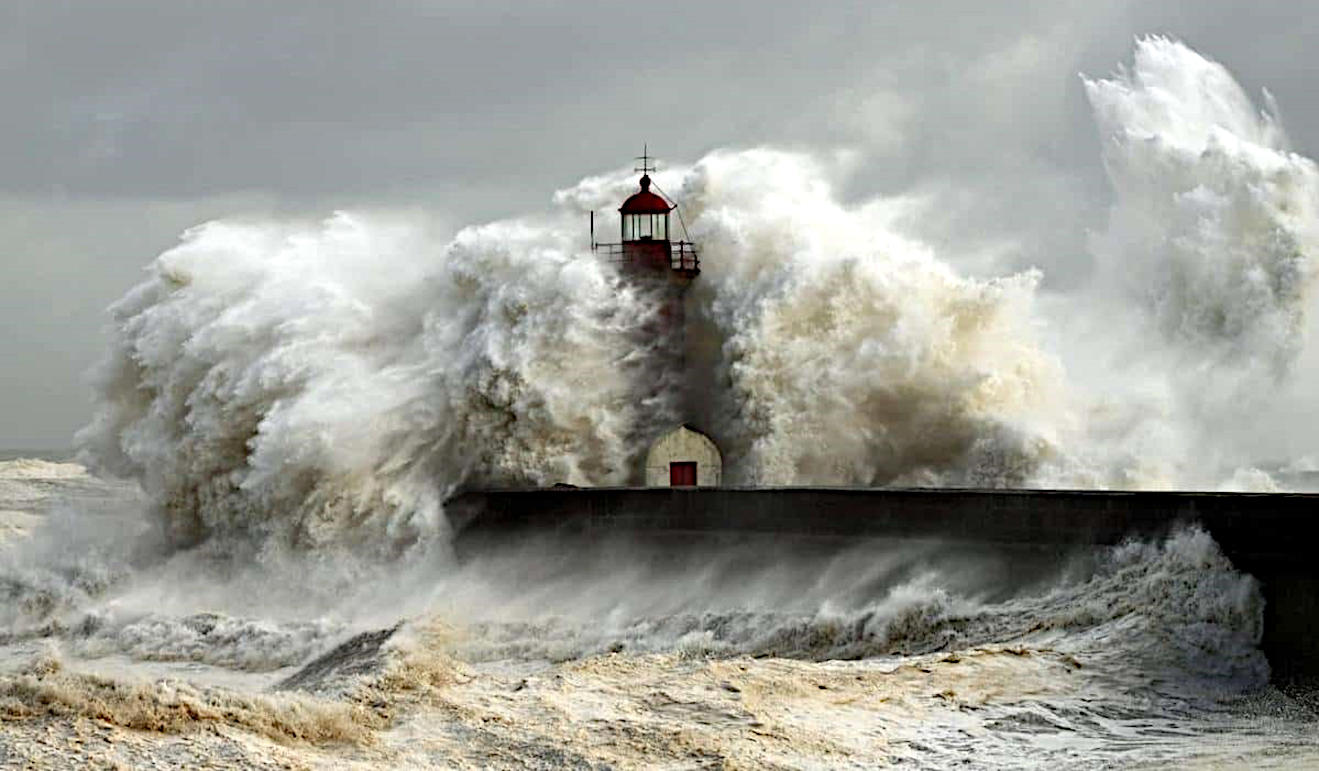
THE
BERMUDA TRIANGLE - Is a geographical region on the North
Atlantic that is known for missing ships and aircraft.
The Bermuda, or Devil's Triangle, is an urban legend focused on a loosely-defined region in the western part of the North Atlantic Ocean where a number of aircraft and ships are said to have disappeared under mysterious circumstances. The idea of the area as uniquely prone to disappearances arose in the mid-20th century, but most reputable sources dismiss the idea that there is any mystery.
The earliest suggestion of unusual disappearances in the Bermuda area appeared in a September 17, 1950, article published in The Miami Herald (Associated Press) by Edward Van Winkle Jones. Two years later, Fate magazine published "Sea Mystery at Our Back Door", a short article by George Sand covering the loss of several planes and ships, including the loss of Flight 19, a group of five US Navy Grumman TBM Avenger torpedo bombers on a training mission. Sand's article was the first to lay out the now-familiar triangular area where the losses took place, as well as the first to suggest a supernatural element to the Flight 19 incident. Flight 19 alone would be covered again in the April 1962 issue of American Legion magazine. In it, author Allan W. Eckert wrote that the flight leader had been heard saying, "We are entering white water, nothing seems right. We don't know where we are, the water is green, no white." He also wrote that officials at the Navy board of inquiry stated that the planes "flew off to Mars."
In February 1964, Vincent Gaddis wrote an article called "The Deadly Bermuda Triangle" in the pulp magazine Argosy saying Flight 19 and other disappearances were part of a pattern of strange events in the region. The next year, Gaddis expanded this article into a
book: Invisible Horizons.
Other writers elaborated on Gaddis' ideas: John Wallace Spencer (Limbo of the Lost, 1969, repr. 1973); Charles Berlitz (The Bermuda Triangle, 1974); Richard Winer (The Devil's Triangle, 1974), and many others, all keeping to some of the same supernatural elements outlined by Eckert.
TRIANGLE AREA
The Gaddis Argosy article delineated the boundaries of the triangle, giving its vertices as Miami; San Juan, Puerto Rico; and Bermuda. Subsequent writers did not necessarily follow this definition. Some writers gave different boundaries and vertices to the triangle, with the total area varying from 1,300,000 to 3,900,000 km2 (500,000 to 1,510,000 sq mi). "Indeed, some writers even stretch it as far as the Irish coast." Consequently, the determination of which accidents occurred inside the triangle depends on which writer reported them.
LARRY KUSCHE
Larry Kusche, author of The Bermuda Triangle Mystery: Solved (1975), argued that many claims of Gaddis and subsequent writers were exaggerated, dubious or unverifiable. Kusche's research revealed a number of inaccuracies and inconsistencies between Berlitz's accounts and statements from eyewitnesses, participants, and others involved in the initial incidents. Kusche noted cases where pertinent information went unreported, such as the disappearance of round-the-world yachtsman Donald Crowhurst, which Berlitz had presented as a mystery, despite clear evidence to the contrary.
Another example was the ore-carrier recounted by Berlitz as lost without trace three days out of an
Atlantic port when it had been lost three days out of a port with the same name in the
Pacific
Ocean. Kusche also argued that a large percentage of the incidents that sparked allegations of the Triangle's mysterious influence actually occurred well outside it. Often his research was simple: he would review period newspapers of the dates of reported incidents and find reports on possibly relevant events like unusual weather, that were never mentioned in the disappearance stories.
Kusche concluded that The number of ships and aircraft reported missing in the area was not significantly greater, proportionally speaking, than in any other part of the ocean, and that in an area frequented by tropical cyclones, the number of disappearances that did occur were, for the most part, neither disproportionate, unlikely, nor mysterious. And
the gentleman may have a point. But these are
disappearances, and that may make a difference.
NOTABLE RECORDED INCIDENTS
HMS ATLANTA
The sail training ship HMS Atalanta (originally named HMS Juno) disappeared with her entire crew after setting sail from the Royal Naval Dockyard, Bermuda for Falmouth, England on 31 January 1880.USS Cyclops
USS CYCLOPS (AC-4)
The incident resulting in the single largest loss of life in the history of the US Navy not related to combat occurred when the collier Cyclops, carrying a full load of manganese ore and with one engine out of action, went missing without a trace with a crew of 309 sometime after March 4, 1918, after departing the island of Barbados. Although there is no strong evidence for any single theory, many independent theories exist, some blaming storms, some capsizing, and some suggesting that wartime enemy activity was to blame for the loss. In addition, two of Cyclops's sister ships, Proteus and Nereus were subsequently lost in the North Atlantic during
World War
II. Both ships were transporting heavy loads of metallic ore similar to that which was loaded on Cyclops during her fatal voyage. In all three cases structural failure due to overloading with a much denser cargo than designed is considered the most likely cause of sinking.
It was presumed that she sank in a powerful storm which crossed her route a couple of weeks after she sailed, and that her crew being composed primarily of inexperienced trainees may have been a contributing factor. The search for evidence of her fate attracted worldwide attention at the time (connection is also often made to the 1878 loss of the training ship HMS Eurydice, which foundered after departing the Royal Naval Dockyard in Bermuda for Portsmouth on 6 March), and she was alleged decades later to have been a victim of the mysterious triangle, an allegation resoundingly refuted by the research of author David Francis Raine in 1997.
CARROLL A. DEERING
Carroll A. Deering, a five-masted schooner built in 1919, was found hard aground and abandoned at Diamond Shoals, near Cape Hatteras, North Carolina, on January 31, 1921.
FBI investigation into the Deering scrutinized, then ruled out, multiple theories as to why and how the ship was abandoned, including piracy, domestic Communist sabotage and the involvement of rum-runners.
FLIGHT 19
Flight 19 was a training flight of five TBM Avenger torpedo bombers that disappeared on December 5, 1945, while over the Atlantic. The squadron's flight plan was scheduled to take them due east from Fort Lauderdale for 141 mi (227 km), north for 73 mi (117 km), and then back over a final 140-mile (230-kilometre) leg to complete the exercise. The flight never returned to base. The disappearance was attributed by Navy investigators to navigational error leading to the aircraft running out of fuel.
One of the search and rescue aircraft deployed to look for them, a PBM Mariner with a 13-man crew, also disappeared. A tanker off the coast of Florida reported seeing an explosion and observing a widespread oil slick when fruitlessly searching for survivors. The weather was becoming stormy by the end of the incident. According to contemporaneous sources the Mariner had a history of explosions due to vapour leaks when heavily loaded with fuel, as it might have been for a potentially long search-and-rescue operation.
STAR TIGER & STAR ARIEL - BSAA Star Tiger disappearance and BSAA Star Ariel disappearance
G-AHNP Star Tiger disappeared on January 30, 1948, on a flight from the Azores to Bermuda; G-AGRE Star Ariel disappeared on January 17, 1949, on a flight from Bermuda to Kingston,
Jamaica. Both were Avro Tudor IV passenger aircraft operated by British South American Airways. Both planes were operating at the very limits of their range and the slightest error or fault in the equipment could keep them from reaching the small island.
DOUGLAS DC-3 - 1948 Airborne Transport DC-3 disappearance
On December 28, 1948, a Douglas DC-3 aircraft, number NC16002, disappeared while on a flight from San Juan,
Puerto
Rico, to Miami. No trace of the aircraft, or the 32 people on board, was ever found. A Civil Aeronautics Board investigation found there was insufficient information available on which to determine probable cause of the disappearance.
CONNEMARA IV
A pleasure yacht was found adrift in the Atlantic south of Bermuda on September 26, 1955; it is usually stated in the stories (Berlitz, Winer) that the crew vanished while the yacht survived being at sea during three hurricanes. The 1955 Atlantic hurricane season shows Hurricane Ione passing nearby between 14 and 18 September, with Bermuda being affected by winds of almost gale force. In his second book on the Bermuda Triangle, Winer quoted from a letter he had received from Mr J.E. Challenor of Barbados:
On the morning of September 22, Connemara IV was lying to a heavy mooring in the open roadstead of Carlisle Bay. Because of the approaching hurricane, the owner strengthened the mooring ropes and put out two additional anchors. There was little else he could do, as the exposed mooring was the only available anchorage. ... In Carlisle Bay, the sea in the wake of Hurricane Janet was awe-inspiring and dangerous. The owner of Connemara IV observed that she had disappeared. An investigation revealed that she had dragged her moorings and gone to sea.
KC-135 STRATOTANKERS
On August 28, 1963, a pair of US Air Force KC-135 Stratotanker aircraft collided and crashed into the Atlantic 300 miles west of Bermuda. Some writers say that while the two aircraft did collide there were two distinct crash sites, separated by over 160 miles (260 km) of water. However, Kusche's research showed that the unclassified version of the Air Force investigation report revealed that the debris field defining the second "crash site" was examined by a search and rescue ship, and found to be a mass of seaweed and driftwood tangled in an old buoy.

REFERENCES
https://en.wikipedia.org/wiki/Bermuda_Triangle
http://www.unmuseum.org/triangle.htm

